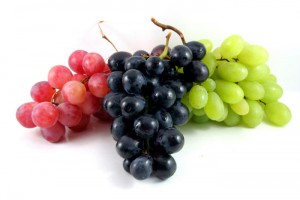September 11, 2015
Yard and Garden: Getting the Most Out of Your Grape Crop
By Richard Jauron
Iowa Stare University Extension – Horticulture
 Grapes are a delicious and nutritious part of any
Grapes are a delicious and nutritious part of any
garden, but there are variables involved when properly harvesting and storing them.
Here are some tips from Iowa State University Extension and Outreach horticulturists on how to get the most out of your grape harvest. To have additional questions answered, contact the ISU Hortline at (515) 294-3108 or hortline@iastate.edu.
When should I harvest grapes?
Grapes must be harvested at the right stage of maturity to insure high quality. There are several indicators of grape maturity. The color, size, sweetness and flavor of the berry are the most useful indicators.
Depending on the cultivar, the berry color changes from green to blue, red or white as the grapes approach maturity. Color alone, however, should not be the sole basis for harvesting grapes. The berries of many cultivars change color long before the grapes are fully ripe. At maturity, individual berries are full size and slightly less firm to the touch. As a final test, taste a few grapes for sweetness when berry size and color indicate they are approaching maturity. Harvest the grape clusters when the berries are sweet.
When harvesting grapes, remove clusters with a knife or hand shears.
How can I store grapes?
Sound grapes can be stored in perforated plastic bags in the refrigerator for up to two months. Optimum storage conditions are a temperature of 31 to 32 degrees Fahrenheit and a relative humidity of 85 percent.
The berries in my grape cluster did not ripen evenly. Why?
Several factors could be responsible for the uneven ripening of the berries within a cluster. Possible causes are over-cropping (too many grape clusters on the vine), a potassium deficiency, moisture stress or 2,4-D damage.
Over-cropping is the most common cause of uneven ripening for home gardeners. An average grapevine may have 200 to 300 buds that are capable of producing fruit. If grapevines are not pruned properly in late winter, the number of fruit clusters may be excessive. The vine is unable to ripen the large crop properly, resulting in uneven ripening of the berries within the clusters. In Iowa, 60 is the maximum number of buds that should remain on a grapevine after pruning.
Grapevines require one inch of water per week, either from rain or irrigation, for good growth and crop production. Irrigate plants weekly during hot, dry weather.
Avoid spraying 2,4-D or other broadleaf herbicides to the lawn in spring or summer. Fall applications provide the best broadleaf weed control and should not adversely affect the grape crop.
Filed Under: Health & Wellness
Trackback URL: https://www.50pluslife.com/2015/09/11/yard-and-garden-getting-the-most-out-of-your-grape-crop/trackback/


